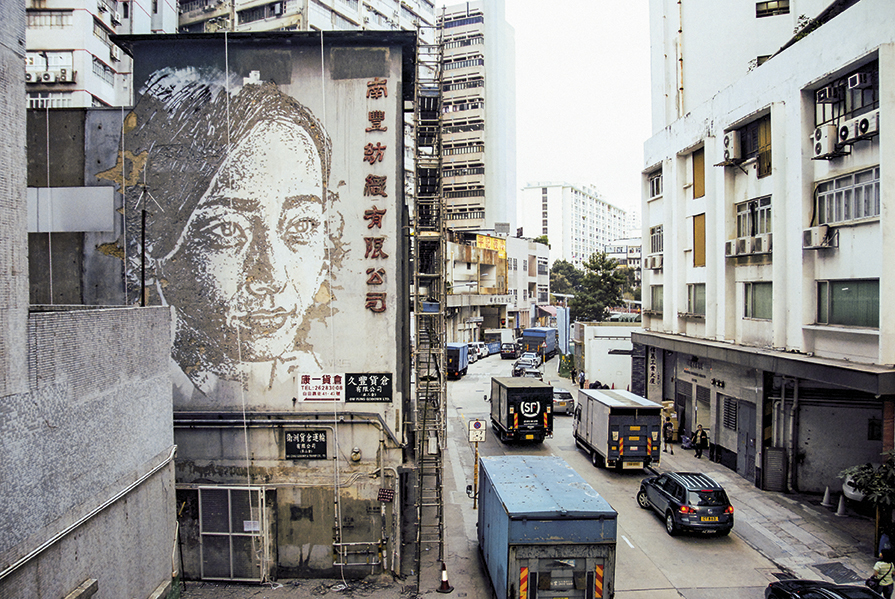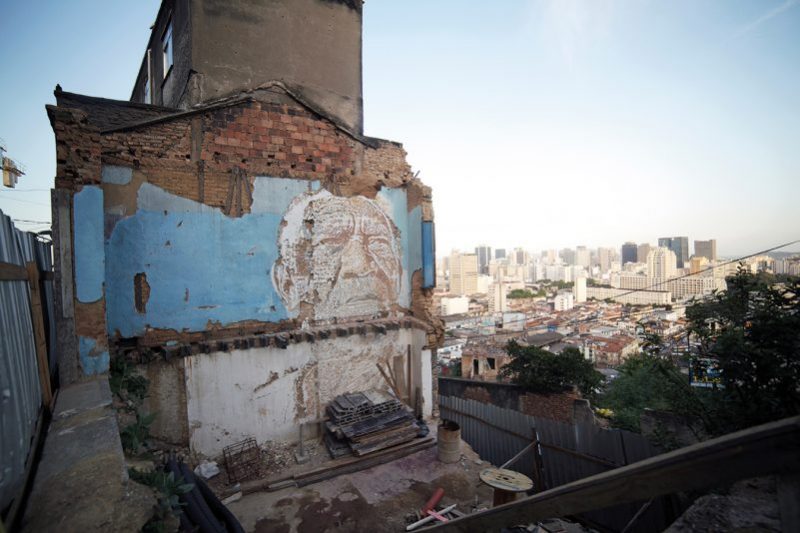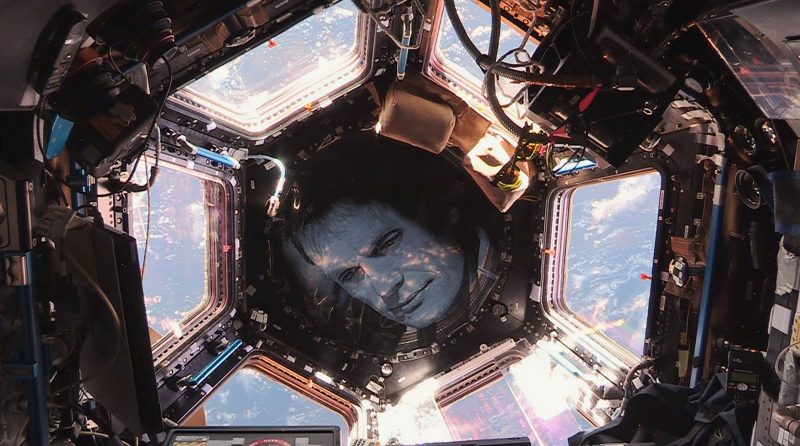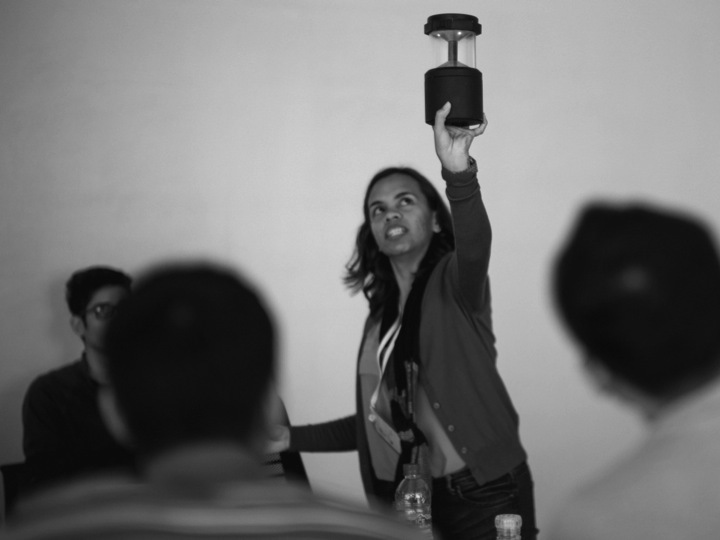Alexandre Farto aka Vhils is a Portuguese artist who got his start as a graffiti writer in the early 2000’s. Vhils found his artistic voice while growing up during the intensive urban development in Seixal, an industrial suburb of Lisbon, during the 80s and 90s. He is best known for his groundbreaking carving technique, which has been hailed as one of the most compelling approaches to street art in the last decade. An avid experimentalist, he has further explored the aesthetics of vandalism in: stencil painting, pyrotechnic explosions, 3D modeling, installations, performance art, a music video for U2 and even space.
Video Credit: Vhils x U2
A few words to describe your aesthetic?
V. I believe in working with the forces of chaos present in the city and making them part of an art that is as transient as the material reality that surrounds us.
Your art is created using destructive methods, essentially subtraction. What do you wish to create, to add?
V. In some bodies of work I also employ non-destructive means, like the Diorama Series in styrofoam and cork, or some of the sculptural pieces I’ve been creating recently in concrete or metal, but yes, most of my work is based on a subtractive approach. In material terms, I want my contribution to be a small nudge in the right direction. The objective is to work with nature and not against it. Once I feel my contribution is done, I want the piece to continue evolving and changing with time and the forces of nature. In conceptual terms:
all the pieces are connected by the reflection which the work is presenting, helping make visible what lies hidden beneath the surface of things, while looking into the relationship between people and the cities they live in and raising issues surrounding the impact of development and mass visual communication on the identity of individuals and communities in the present day urban environment.
I love how sustainable your art is. All the materials exist already on the street and you, as an artist, accelerate entropy and urban decay to create art. You talk a lot about breaking down layers, literally and figuratively. I agree with your term ‘archeology’ to break down literal walls, as well as the layers of socio-political propaganda and advertising. Do you remember when you first ‘broke the surface’ so to speak? (Carving into walls as opposed to surface level painting/graffiti?)
V. Yes, the idea is exactly that, to work with what the city already provides. The subtractive technique I employ today in most of my work basically came about from the convergence of two factors: the recourse to a technique of reverse stenciling coupled with the notion of creative vandalism. After working with stencils for a while, I realised sometime around 2005 that I could reverse the process and create by removing part of the existing layers instead of adding new ones. I first employed this technique on thick agglomerations of advertising posters I removed from the streets, using them like a new form of canvas. As soon as I started cutting through their thick layers, I also realised I was bringing up fragments from past events that were buried beneath the more recent layers. It was like accessing the city’s recent history, and I began viewing this process as an act of contemporary archaeology. I eventually realised that walls are also composed of different layers and that I could apply the same method to them. I did a few tests on the walls of an abandoned factory until I got the technique and the tools right. The first accomplished wall piece with this technique was the one I carved for the VSP group exhibition in Lisbon, in 2007.
Congratulations on your stage production. [PERIFÉRICO . 7 & 8 April | 9pm
Pequeno Auditório – Centro Cultural de Belém, Lisbon] How did you get involved with performance art? Did your past music videos [U2, Orelha Negra] give you good, applicable experience in this discipline?
V. Thank you. I was challenged by John Romão, director of the new BoCA – Biennial of Contemporary Arts, which is taking place this month here in Lisbon and in Porto. He was interested in inviting artists to step outside their comfort zone and take on the challenge of creating in new fields. I found the whole concept very interesting from the beginning and accepted at once. And he was right, it was very challenging, but I worked with a team comprising a choreographer, dancers, VJs and DJs. The resulting performance was a group effort. In a sense yes, I did use a lot of the knowledge I’ve accumulated from my experiences in video, and the performance had a very strong component of video mapping and projections.
 In the Photo: “Dissection” solo exhibition Fundação EDP | Museu da Eletricidade, Lisbon, Portugal June 2014 Location: Avenida de Brasília, Lisbon Photo Credit: Vhils.com
In the Photo: “Dissection” solo exhibition Fundação EDP | Museu da Eletricidade, Lisbon, Portugal June 2014 Location: Avenida de Brasília, Lisbon Photo Credit: Vhils.com
How do you learn a new process? To be honest, I’ve never met an artist who has such a great grasp of so many different medias. Mad respect.
V. This depends on what the process involves. With some everything is somewhat instinctive and I’m able to put the original idea easily intro practice, while others are more demanding. When I got the idea of using explosive charges to carve wall pieces for videos, I had to create the entire process from scratch because it had never been done before. That was probably the most difficult process to master. I teamed up with a specialist in pyrotechnics and we experimented for some 8 months before we got everything right for the first video. It was all trial and error as we were literally breaking new ground. Even the specialist wasn’t sure how to proceed as he’d never used explosives like this before. I’ve always been interested in the experimental side of things, and I like to spend time on trying out new stuff.
There are plenty of ideas and processes that fail, but even these can point me in a new direction.
From initial concept to execution, how long does a project take? How do you decide on a location?
V. All of these depend hugely on the nature, scope and size of the project. For wall pieces, the conception can take some time, depending on the degree of research the project demands and the person or people being portrayed. Despite its technical demands, the painting and carving itself is often the easiest part, as with the help of my production team I can usually set a pace of one story per day. In this sense, a large-scale piece can take a few days working full-time to complete.
You just returned from a trip to Hong Kong. How was your visit? What do you do to experience a new city authentically (beyond touristic sites)?
V. I’m currently dividing my time between Lisbon and Hong Kong, where I opened a second studio in August 2015. Initially it was only supposed to be a short stay for an artist residency program that culminated in the solo show I did last year for Hong Kong Contemporary Art (HOCA) Foundation, but I stayed on. It’s a fantastic place. I spend a lot of my time there just creating, and less focused on the bureaucracy of running a studio and a gallery, like I do in Lisbon. It’s also a very inspiring place, a blend between hi-tech efficiency and the chaos inherent to city life.
Video Credit: “Debris – Works by Alexandre Farto aka Vhils” exhibition
You present commonplace people in a larger than life format, a play with icons. Their often wrinkled faces intimate a life well lived- essentially blasting human history back into a sterile, nondescript wall. How do you meet the people that will become the subjects of your portraits?
V. It depends and varies greatly according to the nature of the project. In projects where the objective is to portray someone with a specific connection with the location, like a community, it’s easy to meet local people, listen to their stories, photograph them and get them to agree to being portrayed. I also meet a lot of people at random while walking the streets of a city and explain what I do and ask them if they want to be part of my project. There are also cases when I create composites from different pictures, in order to create an image that can represent everyone and no one in particular.
Related article: “REINVENTING STREET ART WITH JAVIER DE RIBA“
 In the Photo: Festival Aldeias Artísticas Juncal do Campo, Portugal June 2015 Location: Rua Nova N.º 4, Juncal do Campo Photo Credit: Vhils.com
In the Photo: Festival Aldeias Artísticas Juncal do Campo, Portugal June 2015 Location: Rua Nova N.º 4, Juncal do Campo Photo Credit: Vhils.com
In past interviews, you reference your childhood in Lisbon often. During your travels, do you ever meet children? What advice do you give them?
V. Yes, one of the things I like doing is giving workshops for children and teens. You always end up learning so much from them. They are very intuitive and can easily see past the constrictions of adulthood. I’m not sure if they learn more from what I have to show them or if it’s the other way around. I’m not comfortable giving advice to anyone, let alone kids, I just like working with them and showing them some of the tricks of the trade.
Do you remember your first tag/graffiti?
V. Not in detail. I remember first noticing graffiti on the walls along the route I took to school when I was ten, and feeling its power. That sparked my interest, and soon after I started doodling on my exercise books, just basically copying what I saw and trying to look cool. Soon after that I met a few other kids who were also into graffiti and eventually we began tagging on walls, mainly at school and around school. I only got into it seriously at 13, but by then I had already painted a few very shitty things. The first real piece I did, also very shitty, was in an abandoned factory near my home, I remember that. The rest became unimportant as I picked up skills and got into the whole train bombing scene.
When, in your growth as a young artist, did you first feel accomplished?
V. I think feeling accomplishment is a work in progress. Whenever you reach a certain goal you simply set up new ones. Stopping is not an option. I’ve felt accomplished for having done certain things I wanted to do, but there is so much more out there waiting to be done. The first time I painted on a train was a major accomplishment at the time, but so was the first group exhibition I participated in, the first solo show I produced, the first time I travelled abroad, the first time I carved a piece on a wall, the first time I put a piece in space, the list goes on…
You bring art to communities in the most free, open and accessible way. On the street, do you ever eavesdrop to hear people’s reactions to your work?
V. Absolutely, whenever I can. I’m always interested in knowing what people have to say. Sometimes it’s just impossible though, because when you’re working on a piece outdoors there’s usually a narrow timeframe to complete it and you have to focus on the job at hand.
 In the Photo: Morro da Providência community project Rio de Janeiro, Brazil Oct. 2012 Location: Ladeira do Barroso – Gamboa, Rio de Janeiro Photo Credit: Vhils.com
In the Photo: Morro da Providência community project Rio de Janeiro, Brazil Oct. 2012 Location: Ladeira do Barroso – Gamboa, Rio de Janeiro Photo Credit: Vhils.com
Do you ever check on your past works via Google Maps? (I did while researching this interview) In past interviews, you seem at peace with their own destruction. Simply part of the process of street art?
V. As most of the wall pieces are indexed on my website map I do check up on them from time to time with my team, and we discuss their status when something crops up. I have no problem in seeing them go. Everything has its own lifespan. Even when they remain up for a long time, the objective is for them to change over time, to become absorbed by the very wall and the city they were created in. When you’re working directly with the city you learn to accept these changes and this transience.
You have many accomplishments and high honors across the board, what do you think is next?
V. Only the future will tell…
When you’re not creating, what are you up to?
V. Catching up on much-needed sleep, mostly! But when I can, I like to spend time with family and friends, watch films, listen to music, read, or simply chill out and do nothing.
 In the Photo: Cupola module, International Space Station Oct. 2012 “The Meaning of Life” dir. Miguel Gonçalves Mendes Photo Credit: Vhils.com
In the Photo: Cupola module, International Space Station Oct. 2012 “The Meaning of Life” dir. Miguel Gonçalves Mendes Photo Credit: Vhils.com
Recommended reading: “THE SOPHISTICATION OF STREET ART”














